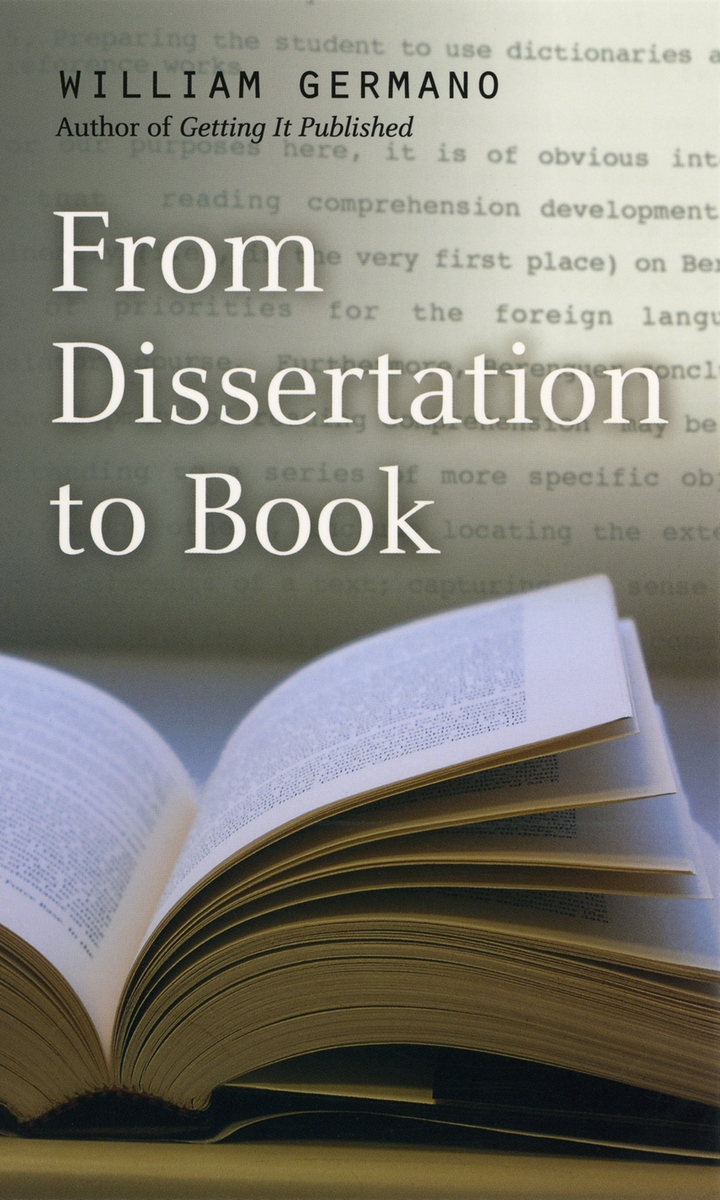From Dissertation to Book
University of Chicago Press, 2005
Cloth: 978-0-226-28845-1 | Paper: 978-0-226-28846-8 | Electronic: 978-0-226-28847-5
DOI: 10.7208/chicago/9780226288475.001.0001
Cloth: 978-0-226-28845-1 | Paper: 978-0-226-28846-8 | Electronic: 978-0-226-28847-5
DOI: 10.7208/chicago/9780226288475.001.0001
AVAILABLE FROM
This title is no longer available from this publisher at this time. To let the publisher know you are interested in the title, please email bv-help@uchicago.edu.
ABOUT THIS BOOKAUTHOR BIOGRAPHYTABLE OF CONTENTS
ABOUT THIS BOOK
All new Phd's hope that their dissertations can become books. But a dissertation is written for a committee and a book for the larger world. William Germano's From Dissertation to Book is the essential guide for academic writers who want to revise a doctoral thesis for publication. The author of Getting It Published, Germano draws upon his extensive experience in academic publishing to provide writers with a state-of-the-art view of how to turn a dissertation into a manuscript that publishers will notice.
Acknowledging first that not all theses can become books, Germano shows how some dissertations might have a better life as one or more journal articles or as chapters in a newly conceived book. But even dissertations strong enough to be published as books first need to become book manuscripts, and at the heart of From Dissertation to Book is the idea that revising the dissertation is a fundamental process of adapting from one genre of writing to another.
Germano offers clear guidance on how to do just this. Writers will find advice on such topics as rethinking the table of contents, taming runaway footnotes, shaping chapter length, and confronting the limitations of jargon, alongside helpful timetables for light or heavy revision. With crisp directives, engaging examples, and a sympathetic eye for the foibles of academic writing, From Dissertation to Book reveals to recent PhD's the process of careful and thoughtful revision—a truly invaluable skill as they grow into their new roles as professional writers.
Acknowledging first that not all theses can become books, Germano shows how some dissertations might have a better life as one or more journal articles or as chapters in a newly conceived book. But even dissertations strong enough to be published as books first need to become book manuscripts, and at the heart of From Dissertation to Book is the idea that revising the dissertation is a fundamental process of adapting from one genre of writing to another.
Germano offers clear guidance on how to do just this. Writers will find advice on such topics as rethinking the table of contents, taming runaway footnotes, shaping chapter length, and confronting the limitations of jargon, alongside helpful timetables for light or heavy revision. With crisp directives, engaging examples, and a sympathetic eye for the foibles of academic writing, From Dissertation to Book reveals to recent PhD's the process of careful and thoughtful revision—a truly invaluable skill as they grow into their new roles as professional writers.
AUTHOR BIOGRAPHY
William Germano is vice president and publishing director at Routledge. He has been editor in chief at Columbia University Press, where he also served as humanities editor.
TABLE OF CONTENTS
Acknowledgments
1 WHY THIS BOOK
2 GETTING STARTED, AGAIN
3 NAGGING DOUBTS
4 THE BASIC OPTIONS
5 READING WITH AN EDITOR'S EYES
6 PLANNING AND DOING
7 GETTING INTO SHAPE
8 MAKING PROSE SPEAK
9 WHAT HAPPENS NEXT
Three Checklists
For Further Reading
Index
